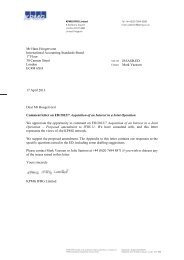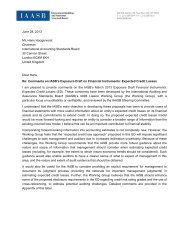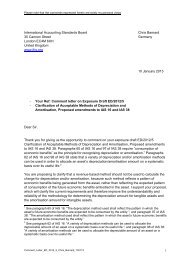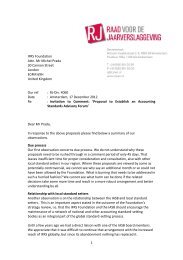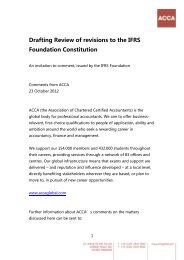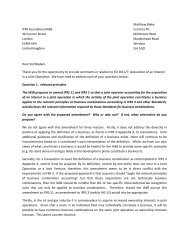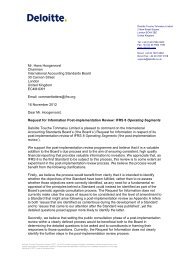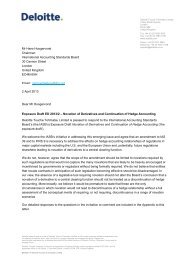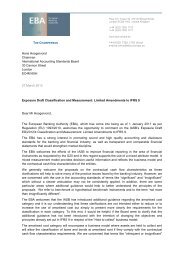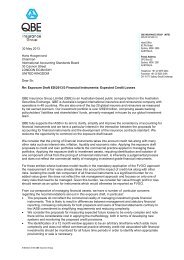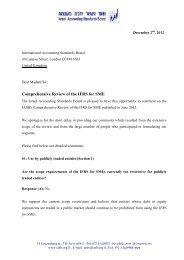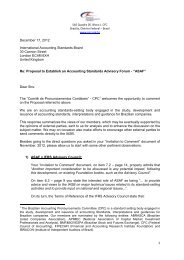Classification and Measurement: Limited Amendments to IFRS 9
Classification and Measurement: Limited Amendments to IFRS 9
Classification and Measurement: Limited Amendments to IFRS 9
Create successful ePaper yourself
Turn your PDF publications into a flip-book with our unique Google optimized e-Paper software.
March 26, 2013<br />
Mr. Hans Hoogervorst<br />
Chairman<br />
International Accounting St<strong>and</strong>ards Board<br />
30 Cannon Street<br />
London, EC4M 6XH<br />
United Kingdom<br />
Reference: Exposure Draft ED/2012/4, <strong>Classification</strong> <strong>and</strong> <strong>Measurement</strong>: <strong>Limited</strong><br />
<strong>Amendments</strong> <strong>to</strong> <strong>IFRS</strong> 9<br />
Dear Mr. Hoogervorst:<br />
The Mortgage Bankers Association 1 (MBA) appreciates the opportunity <strong>to</strong> comment on<br />
Exposure Draft ED/2012/4, <strong>Classification</strong> <strong>and</strong> <strong>Measurement</strong>: <strong>Limited</strong> <strong>Amendments</strong> <strong>to</strong><br />
<strong>IFRS</strong> 9 (Proposed Amendment). MBA’s response is driven by the overarching premise<br />
that accounting <strong>and</strong> reporting for financial instruments should reflect both a reporting<br />
entity’s business strategy <strong>and</strong> the characteristics of the financial instruments. MBA<br />
generally supports the introduction of a fair value through other comprehensive income<br />
(OCI) classification for financial assets held within a business model in which assets are<br />
managed both in order <strong>to</strong> collect contractual cash flows <strong>and</strong> for possible sale. However,<br />
MBA has significant concerns with respect <strong>to</strong> a rule within the existing <strong>IFRS</strong> 9.<br />
Specifically, B4.21 states:<br />
In such transactions, a tranche has cash flow characteristics that are payments of<br />
principal <strong>and</strong> interest on the principal amount outst<strong>and</strong>ing only if:<br />
1 The Mortgage Bankers Association (MBA) is the national association representing the real estate<br />
finance industry, an industry that employs more than 280,000 people in virtually every community in the<br />
country. Headquartered in Washing<strong>to</strong>n, D.C., the association works <strong>to</strong> ensure the continued strength of<br />
the nation's residential <strong>and</strong> commercial real estate markets; <strong>to</strong> exp<strong>and</strong> homeownership <strong>and</strong> extend<br />
access <strong>to</strong> affordable housing <strong>to</strong> all Americans. MBA promotes fair <strong>and</strong> ethical lending practices <strong>and</strong><br />
fosters professional excellence among real estate finance employees through a wide range of educational<br />
programs <strong>and</strong> a variety of publications. Its membership of over 2,200 companies includes all elements of<br />
real estate finance: mortgage companies, mortgage brokers, commercial banks, thrifts, REITs, Wall<br />
Street conduits, life insurance companies <strong>and</strong> others in the mortgage lending field. For additional<br />
information, visit MBA's Web site: www.mortgagebankers.org.<br />
1717 Rhode Isl<strong>and</strong> Ave, NW | Washing<strong>to</strong>n, DC 20036 | www.mortgagebankers.org | (202) 557-2700
Letter <strong>to</strong> IASB<br />
March 26, 2013<br />
Page 2<br />
(a) the contractual terms of the tranche being assessed for classification<br />
(without looking through <strong>to</strong> the underlying pool of financial instruments) give rise <strong>to</strong> cash<br />
flows that are solely payments of principal <strong>and</strong> interest on the principal amount<br />
outst<strong>and</strong>ing (e.g., the interest rate on the tranche is not linked <strong>to</strong> a commodity index);<br />
(b) the underlying pool of financial instruments has the cash flow characteristics set out<br />
in paragraphs B4.1.23 <strong>and</strong> B4.1.24; <strong>and</strong><br />
(c) the exposure <strong>to</strong> credit risk in the underlying pool of financial instruments inherent in<br />
the tranche is equal <strong>to</strong> or lower than the exposure <strong>to</strong> credit risk of the underlying pool of<br />
financial instruments (for example, this condition would be met if the underlying pool of<br />
instruments were <strong>to</strong> lose 50 per cent as a result of credit losses <strong>and</strong> under all<br />
circumstances the tranche would lose 50 per cent or less). 2<br />
Thus, if the range of expected loss for a tranche of a mortgage backed security (MBS) is<br />
greater than the weighted average range of expected losses of the underlying pool of<br />
mortgages, then that tranche would have <strong>to</strong> be measured at fair value through the<br />
income statement. Otherwise, it could be measured at fair value through OCI. MBA<br />
notes that this would force all but the most senior tranche in multi-tranche mortgagebacked<br />
securities (MBS) <strong>to</strong> be accounted for at fair value through net income even<br />
though the securities are managed both in order <strong>to</strong> collect contractual cash flows <strong>and</strong><br />
for a possible sale.<br />
Inconsistent With Principle of Accounting Following Business Model<br />
MBA believes that if a debt financial instrument is not held for trading purposes, it<br />
should be eligible <strong>to</strong> be accounted for at fair value through OCI or at amortized cost,<br />
depending on the business purpose of holding the instrument. For assets where the<br />
primary objective is <strong>to</strong> be used for investing purposes that may result in the asset being<br />
either held for collection of cash flows or sold at a future date, the asset should be<br />
recorded at fair value with changes in fair value reflected in OCI. This should be true<br />
regardless of the existence of tranches.<br />
Payments <strong>to</strong> Each Tranche Holder Represent Principal <strong>and</strong> Interest<br />
In a multiple-tranche security, the payments represent contractual payments of principal<br />
<strong>and</strong> interest, <strong>and</strong> those payments come from the contractual cash flows of the<br />
underlying pool of mortgages. The highest rated tranche generally is paid sooner in the<br />
waterfall <strong>and</strong> accepts a lower effective interest rate for shorter duration <strong>and</strong> resulting<br />
reduced credit risk. Lower tranches are paid lower in the cash flow waterfall (still from<br />
principal <strong>and</strong> interest of the underlying pool of mortgages). They receive a higher<br />
effective yield because of a longer duration <strong>and</strong> resulting increase in credit risk. All<br />
tranche holders are paid solely from principal <strong>and</strong> interest <strong>and</strong> should be deemed <strong>to</strong><br />
meet the cash flow characteristics under <strong>IFRS</strong> 9. MBA believes these tranches meet<br />
2 <strong>IFRS</strong> 9, paragraph B4.1.21, page A351.
Letter <strong>to</strong> IASB<br />
March 26, 2013<br />
Page 3<br />
the cash flow characteristics, <strong>and</strong> the distinction made in <strong>IFRS</strong> 9 for lower tranches is<br />
arbitrary <strong>and</strong> lacking accounting principles support.<br />
Tranches Are Chosen <strong>to</strong> Meet Inves<strong>to</strong>rs’ Long-term Investment Needs<br />
The fact that a securitization has multiple credit risk tranches is not relevant <strong>to</strong> the<br />
accounting for that asset. The use of tranches provides inves<strong>to</strong>rs with choices of<br />
duration, yield <strong>and</strong> credit risk. Some inves<strong>to</strong>rs desire a shorter duration <strong>and</strong> reduced<br />
credit risk <strong>and</strong> are willing <strong>to</strong> give up some yield. Others desire a longer duration <strong>and</strong><br />
have more of an appetite for credit risk in order <strong>to</strong> achieve a higher yield. It doesn’t<br />
mean that those inves<strong>to</strong>rs are not holding the respective tranches for contractual cash<br />
flows.<br />
Existence of Credit Risk Is Not Relevant <strong>to</strong> <strong>Classification</strong> <strong>and</strong> <strong>Measurement</strong><br />
Single tranche securitizations <strong>and</strong> multiple tranche securitizations all have credit risk as<br />
do whole loans. The potential for credit losses should not impact classification <strong>and</strong><br />
measurement, <strong>and</strong> credit risk should be dealt with in the impairment portion of the<br />
financial instruments project.<br />
Inves<strong>to</strong>rs invest in different tranches <strong>to</strong> meet their long-term investment needs. If they<br />
expect losses at purchase, they do not buy the securities at par. On an ongoing basis<br />
they will evaluate for impairment <strong>and</strong> take subsequent impairment charges through net<br />
income, as appropriate. Both the IASB <strong>and</strong> the FASB believe that there should be one<br />
accounting model for debt instruments acquired in whole loan or security form. If a<br />
reporting entity buys whole loans at a discount, the accounting is not required <strong>to</strong> be fair<br />
value through net income. If there is truly going <strong>to</strong> be one accounting model for debt<br />
instruments, FASB should not introduce a credit overlay as part of its measurement<br />
guidance. Rather, classification <strong>and</strong> measurement should be part of one integrated<br />
model for all debt instruments, <strong>and</strong> there should be one separate model for impairment<br />
measurement.<br />
Proposed Accounting for Lower Tranches Is Less Transparent<br />
Fair value through profit <strong>and</strong> loss should be used for financial assets that are held for<br />
sale. Lower tranches that a reporting entity holds for the collection of principal <strong>and</strong><br />
interest or for sale should be carried at fair value through OCI. To do otherwise will<br />
result in less transparent, if not confusing, accounting <strong>and</strong> reporting <strong>to</strong> inves<strong>to</strong>rs by<br />
obfuscating the business purpose for holding the asset.<br />
Results in Short-term Volatility of Net Income<br />
Reporting short-term, unrealized losses through net income on structured securities will<br />
result in unnecessary short-term volatility of earnings as gains <strong>and</strong> losses reverse. A<br />
reporting entity’s reported income for the quarter could be dependent on the last
Letter <strong>to</strong> IASB<br />
March 26, 2013<br />
Page 4<br />
economic announcement, during the final hours or minutes of a quarter. This makes<br />
sense for trading account assets but not for assets held for investment.<br />
Impact on Marketability <strong>and</strong> Liquidity of Important Asset Class<br />
Structured securities support a broad range of credit finance including commercial real<br />
estate loans; residential mortgage loans that do not qualify for Ginnie Mae, Fannie Mae<br />
or Freddie Mac MBS; au<strong>to</strong> loans, <strong>and</strong> credit card loans. The proposed accounting rule<br />
would adversely impact the marketability <strong>and</strong> liquidity of this very important asset class<br />
because of the potential volatility in net income.<br />
MBA appreciates the opportunity <strong>to</strong> share its observations with you. Any questions<br />
about the information provided herein should be directed <strong>to</strong> me, Vice President<br />
Financial Accounting <strong>and</strong> Public Policy <strong>and</strong> Staff Representative <strong>to</strong> MBA’s Financial<br />
Management Committee, at (202) 557-2860 or jgross@mortgagebankers.org.<br />
Sincerely,<br />
James P. Gross<br />
Vice President of Financial Accounting <strong>and</strong> Public Policy



